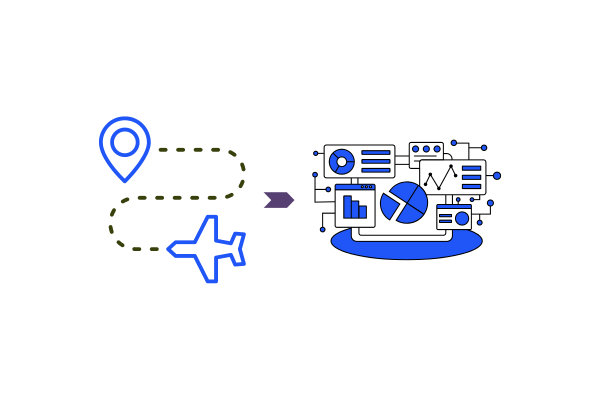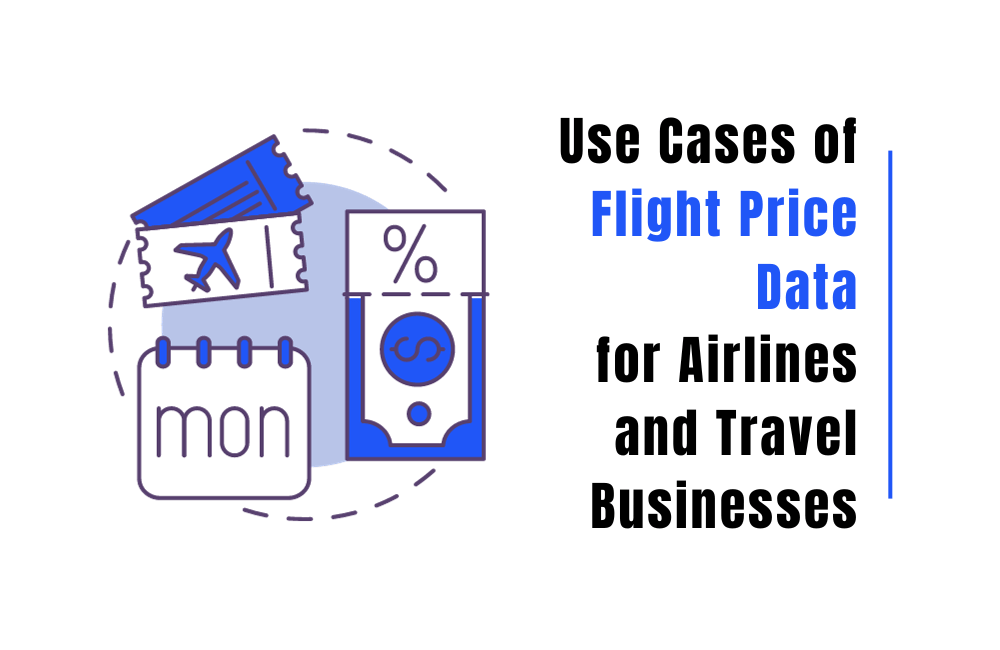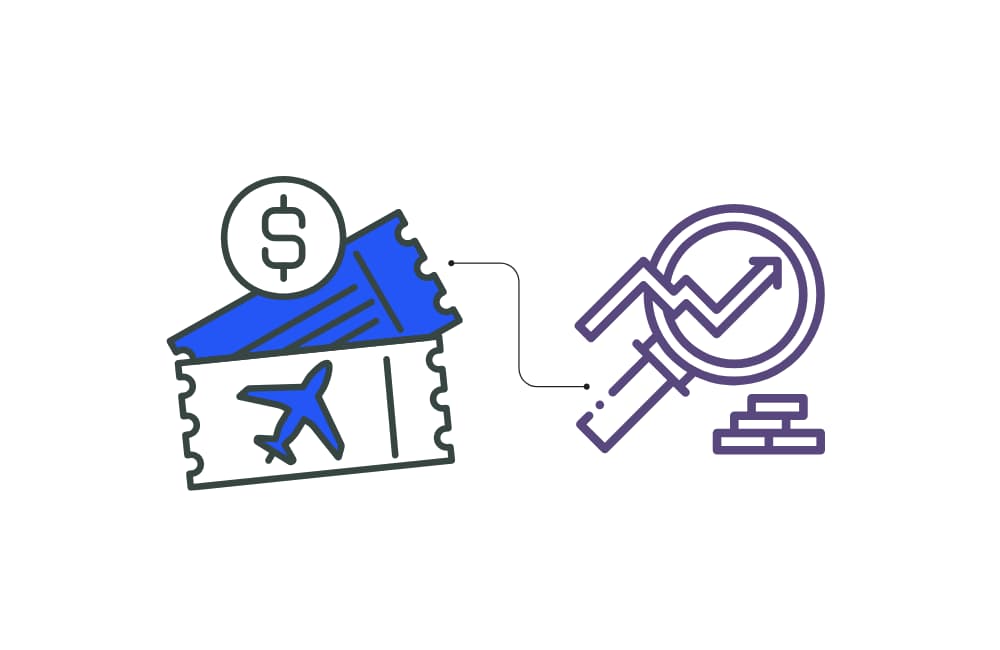The Role of Real-Time Flight Status Data in the Travel Industry

We are living in an age where time is more valuable than anything else. The demands of air travel can frequently create a sense of time-related uncertainty which turns the experience into a delicate balance against the clock Missed connections, delayed departures, and the dreaded last-minute cancellations can turn any pleasure trip into an annoying experience. But, what if you could keep track of flight status in real-time and take the necessary steps to avoid delays and cancellations? Well, it’s just the insight of how helpful flight status data is for travel businesses. Read further to know more. The Role of Real-Time Flight Status Data in the Travel Industry 1. Enhanced Passenger Experience Leveraging this data businesses can get timely updates about the flight’s status and notify you directly to your smartphone. This means you don’t have to keep watching screens at the airport or wait for occasional updates. Whether it’s a gate change, a delay, or an early arrival, you always stay informed. This allows passengers to make informed decisions, such as spending extra minutes in the lounge or rebooking a missed connection before the masses. For travel companies, this is a significant advantage that enhances customer satisfaction and reduces the likelihood of frustration. 2. Streamlined Operations for Airlines and Airports Monitoring flight status in real-time allows airlines & airports to optimize gate assignments, manage ground services more efficiently, and reduce the turnaround time for aircraft. This not only improves the utilization of resources but also minimizes the domino effect of delays which leads to a smoother operation and a better experience for travelers. 3. Enhanced Communication and Customer Service Airlines and travel agencies use this data to proactively for informing passengers about changes that reduce frustration and confusion during travel disruptions. This proactive approach builds trust and loyalty, as passengers appreciate being kept in the loop. 4. Decision Support for Travelers and Businesses Travel agents and business travel managers use this data for planning alternative travel arrangements in case of disruptions to make sure that business meetings or connections are not missed. Plus travelers get informed on time with an alternative solution that brings peace of mind which otherwise would have ended up in bitterness. Apart from the flight status data, there are other types of data needs such as flight seats, room avaialblity and flight & hotel pricing businees need to make informed decision. Check out these travel api providers to satiate your travel data needs. Looking for Precise Flight Status Data? Your Search Ends Here! To get this data, you can use a Flight Status API offered by FlightAPI which lets you monitor flights globally with a simple GET request. This API provides real-time details such as arrival and departure airport codes, timings, and live status in a JSON format. It’s designed for both commercial and private airplanes. The data provided by this API is sourced directly from the airlines and industry partners to avoid errors. With this API, you can track flights up to three days in advance and access schedules of flights from the past two days. To learn more about how to use this API, you can read this guide. And if you want to try it out before committing to a paid plan, sign up for a free trial with 10 API calls.
How To Get Flight Status Data?

Whether you run a travel company or a developer needs real-time flight status data, our step-by-step guide makes accessing this a breeze. Let’s begin by understanding the data you can get from flight status APIs. Type of Data You Will Get Through The API This is the sample response you will get by using this API: To know more check out the documentation from here. How to Get Flight Status Data With an API? We will sign up for a Flight Status API. This API provides free 30 credits for testing. Before we start coding you should read the documentation of this API. We will be using Python 3.x for this example. I am hoping that you have already installed Python on your machine and if not then you can download it from here. Requirements You will have to download the requests library using pip. This library will be used for making an HTTP connection with the API. Getting Flight Status For this example, we are going to track American Airlines(AA) flight number 15. In the above example, we are sending a GET request to /airline endpoint. We have passed the number of the flight as 56, the name as AA, and the date as 20240125 which means 25th Jan 2024. Once you run this code you will get this JSON data. This data contains every little detail like: With this API you can track any flight around the globe. Why Use This? Real-Time Updates: This comes under one of the most demanding travel APIs. Using this you can access up-to-the-minute information which allows you to instantly adapt to any changes in your flight’s status. Accuracy and Reliability: These APIs get information from authoritative data sources to ensure that the information you receive is reliable and accurate. Integration Capabilities: You can seamlessly integrate with other applications to enhance your overall travel experience by connecting with the services you already use. Cost-Effective Solution: You can take a monthly subscription as per your uses to enjoy a budget-friendly option compared to traditional methods, without compromising on the quality and depth of the information you receive. Conclusion Utilizing an API to get flight status data empowers airline and travel businesses and developers. Real-time updates, accuracy, and seamless integration capabilities redefine the operational efficiency of businesses. Getting flight status data is a breeze with our API, and the best part is, that you can try it for free with 10 API calls.
Role of Business Intelligence in the Airline Industry

In the airline industry precision and efficiency are paramount. No wonder, the adoption of Business Intelligence (BI) is surging significantly. According to a Statista report, by 2022, approximately 50 % of airports are poised to leverage BI for optimizing aircraft turnaround, and these numbers are continually growing. Business intelligence uses data to provide valuable insights, helps airlines make smart decisions, and improves how they operate. Without it, airlines run the risk of operating without proper guidance which can lead to operational inefficiencies and missing growth opportunities Business intelligence is an essential weapon for the airline industry to make their business thrive. In this article, we will talk about how to do that. So, let’s get started. How Airlines Can Use Business Intelligence? 1. Helps in Revenue Management Airlines use BI tools to analyze historical data, weather patterns, and competitors pricing data to optimize their pricing strategies. They use flight prices API to check competitors’ prices and various weather forecasting and observation tools for weather insights. Apart from this, by using business intelligence airline businesses can understand customer behavior and market trends to make informed decisions for maintaining inventory levels to avoid excessive and underbooking, because using either one is bad for sustainable revenue growth. Overbooking can lead to unsatisfied customers, which affects the reputation and future bookings, and fewer bookings simply lose profit. 2. Flight Schedule Management to Reduce Delays and Cancellations BI, combined with the Flight Tracking API, allows airlines to monitor flight status and tracking data in real-time. This data is crucial for reducing delays and cancellations by helping airlines proactively address potential issues that can cause delays on time. Through continuous monitoring and analysis, airlines can optimize operational efficiency, minimize disruptions, and ensure a smoother travel experience for passengers. 3. Predictive Analysis & Demand Forecasting Demand forecasting in the airline industry is a complex task involving considerations such as economic conditions, seasonal fluctuations, holidays, and local events. BI tools assist airlines in accurately predicting passenger demand on specific routes at different times of the year by incorporating flight price forecast data. By optimizing flight schedules based on these forecasts, airlines can efficiently meet customer demand, which avoids both empty seats and overbooking scenarios. 4. Customer Satisfaction Customer reviews and comments on social media can make or break any business including the airline. Business intelligence comes here for rescue. It allows airlines to improve customer satisfaction by automating high-volume requests, identifying staff training needs for faster issue resolution, and promptly addressing systemic issues. In addition to that, business intelligence enables predictive scheduling based on anticipated service volumes, efficient allocation of staff across channels, and cost-effective operations. Monitoring overflowing requests allows airlines to address key issues, correlating satisfaction scores with performance metrics for targeted improvements to ensure a seamless and satisfying passenger experience. To streamlines this process even better, you can integrate workflow automation that will help you in swiftly managing requests and enhance overall efficiency. 5. Safety and Airplane Maintenance Safety is a top priority for airlines, and BI plays a crucial role in ensuring it. Airlines analyze flight data, maintenance records, and incident data using BI tools to identify patterns and potential risk factors. Additionally, BI is instrumental in monitoring weather conditions, air traffic control information, and other variables that impact safety in aviation. In addition, by analyzing data on the performance of various aircraft parts and systems, airlines can proactively identify potential issues and schedule timely maintenance or repairs that ensure the safety of passengers and the longevity of the fleet. 6. Crew Management Business intelligence is also utilized in crew management to optimize resource utilization. By analyzing data from past flights, airlines can identify patterns in crew usage and make data-driven adjustments. For example, if a certain flight type requires more crew members, BI applications help in analyzing and assigning the appropriate number of crew members based on individual skills and strengths to those flights. 7. Improve Operational Efficiency It’s quite hard to improve operational efficiency while being in an industry that collects an abundance of revenue but can’t keep much profit. Well, business intelligence emerges as a solution to this, as it offers insights into critical areas such as passenger boarding, flight maintenance metrics, and flying operations. By addressing issues that cause delays, optimizing processes, and streamlining flying times, airlines can reduce costs and improve overall performance. Furthermore, through BI they can do predictive analytics to do proactive planning for potential delays and schedule changes to stay prepared and responsive which ultimately improves operational efficiency. 8. Streamline Supply Chain Handling the supply chain is not simple. One tiny mistake can cause big losses. Therefore, to mitigate mistakes, Business Intelligence is crucial. This helps to trade the fine line between excess inventory costs and lost sales. By harnessing predictive analytics, airlines fine-tune in-flight offerings, optimize inventory to meet demand, minimize waste, and maximize revenue at every turn. 9. Optimize Marketing ROI In the online era of information overload business intelligence can help airlines to grab customer’s attention. By analyzing marketing spend versus revenue and gross margin across various media, BI facilitates the optimal allocation of resources. Additionally, examining budget allocation to different demographics helps in precise targeting. Plus, by leveraging predictive data analytics, airlines can forecast potential revenue from diverse channels which enhances the efficiency of marketing spend. Conclusion: For airlines, Business Intelligence is like a reliable guide. It helps them make smart decisions, from making more money to keeping things running smoothly and the customers satisfied with their services. As technology keeps advancing, Business Intelligence is becoming the must have for airlines to stay ahead in the game. If you’re in the airline industry, start utilizing business intelligence to make your business thrive.
Use Cases of Flight Price Data for Airlines and Travel Businesses

In an age dominated by digital transformation, the aviation and travel industry thrives on real-time data to drive business strategies. Although, there are other data such as customers, bookings, and more that are included. But, flight price data is crucial as it guides airlines and travel businesses for informed decision-making in terms of customer preferences, seasonal demand fluctuations, and competitive landscapes. In this article, we will talk about the use cases of flight price data for airlines and travel businesses and the ways to get flight price data. So, let’s explore why an airline and travel business like yours needs flight price data to thrive. Use Cases Of Flight Data For Airlines Dynamic Pricing: Airlines have advanced beyond static pricing structures. Embracing dynamic pricing models allows them to tap into real-time flight price data which allows them to adjust fares based on factors like demand surges, competitor strategies, market conditions, and distinct customer behaviors. While static pricing may cater to urgent buyers with fixed schedules, it’s suboptimal for those who plan or can afford to wait. Also, the surge in flight price comparison apps and websites further underscores the need for airlines to adopt dynamic pricing. The dynamic pricing approach not only ensures competitiveness in an age of digital price transparency but also maximizes revenue by catering to the varied purchasing habits of today’s travelers. Revenue Management: Flight price data stands at the core of modern revenue management systems for airlines. By analyzing historical and current price trends through advanced flight price predictor tools, airlines can effectively forecast demand, identifying peak periods and potential downtimes. This analysis allows them to set optimal fares for each flight to sell the maximum seats at the best price possible, increasing profitability and efficiency. Marketing and Sales: In the age of data-driven marketing, flight price data is a treasure trove for airlines. It helps them recognize the fare preferences and booking patterns of passengers that enables airlines to craft personalized offers, discounts, and promotions that resonate with individual travelers. By leveraging WhatsApp Business automation, airlines can send timely updates and exclusive deals directly to passenger’s smartphones that leads to enhance engagement and convenience. Additionally, incorporating email marketing and social media campaigns allows airlines to reach a broader audience to ensure that their promotional strategies are comprehensive and effective. This multi-channel approach not only boosts sales but also fosters loyalty and encourages repeat bookings. Customer Service: Contrary to what might seem obvious, flight price data plays a crucial role in elevating the customer service experience. When faced with complaints or queries about fare discrepancies or booking changes. Airlines equipped with real-time price data can offer swift, informed resolutions. Additionally, by understanding fare trends, they can proactively address potential issues or offer fare adjustments which helps them solidify their reputation for impeccable customer support. Use Cases Of Flight Data For Travel Agencies Flight Search and Booking: Like every business, in the travel business customer satisfaction is paramount. By leveraging real-time flight price data, they can ensure that customers are presented with the most competitive flight fare options. This not only helps in selling but also in customer retention, and referrals as well as positions the business as a trusted source for cost-effective travel to increase their market appeal. Travel Packages: Integrated travel experiences have become the hallmark of efficient travel planning. By utilizing flight price data, travel businesses can provide their customers with the most affordable flights and are able to craft even more attractive packages within their budgets. This holistic approach provides travelers with a seamless experience and offers travel businesses an avenue for upselling complementary services as well. Corporate Travel Management: Corporations often require frequent and planned travel for their employees. By using flight pricing data travel agencies can offer invaluable insights to these corporate clients. This data-driven approach enables corporate travel management to optimize their travel budgets, negotiate favorable deals with airlines, and ensure their employees travel comfortably and economically. Travel Analytics and Research: Airlines and travel businesses utilize various data sources along with flight prices to inform their business strategies. External market research studies provide insightful information on larger market dynamics, consumer behavior, and industry trends. In addition to online traffic measurements, this information can be used to gain a better understanding of how people interact with their online platforms and implement appropriate usability and engagement enhancements. By utilizing travel data analytics, companies can gain knowledge and make wise judgments in the travel sector by gathering, analyzing, and interpreting data from multiple sources. So, you have learned all the use cases of flight price data for airlines and travel businesses, now the question is how do they source flight pricing data? No worries, we have covered that too. How Do They Get Flight Pricing Data? Flight pricing data is acquired through various methods such as direct airline partnerships to third-party consolidators. However, these methods can be time-consuming and optimal for getting real-time pricing data. To provide fast, secure, and reliable data, APIs (Application Programming Interfaces) have emerged as popular data sources among businesses. Flight prices API allows online travel agencies and businesses to access real-time fare information from various online travel agencies which allows them to access the most competitive flight fares for their customers. Learn how to access flight price data with an API by watching the tutorial on using FlightAPI for live flight data. Conclusion: In this article, we have talked about how harnessing flight price data is essential for driving informed decisions and staying ahead of the curve. Both airlines and travel businesses stand to gain unparalleled insights which enables them to offer better value to their customers. As the demand for personalized and efficient travel experiences grows, leveraging this data is no longer optional but imperative. To truly thrive in today’s market, it’s essential for airline and travel businesses to embrace flight pricing data to turn it into a strategic asset for growth, customer satisfaction, and retention. However, businesses in travel industry requires travel data for growth,
How Do Travel Agents Use Flight API To Help Their Clients Find The Best Flights?

Did you know, according to the article published on trip.com 90,000 passenger flights take off per day? That’s a lot of wings in the air! Among these vast numbers, how do travel agents consistently manage to find the best flights for their clients? The answer is utilizing Flight API. So, let’s find out more about it. What is a Flight API? A Flight API (Application Programming Interface) is a crucial technological tool that helps travel agents plan their client’s flights. More precisely, it’s the compass that points them to the best flights, the stopwatch that ensures real-time bookings, and the trusty sidekick that allows them to deliver top-notch personalized services. It’s time to lift the veil and understand Flight API’s remarkable benefits and capabilities. How is the Flight API Useful For Travel Agents? Check out what exactly makes Flight API a vital asset in a travel agent’s arsenal. 1. Find the best deals on flights When it comes to air travel, prices fluctuate constantly due to a myriad of factors from demand to seasonality. Travel agents equipped with Flight Price Data API have the advantage of real-time price monitoring. You can think of it as having a hawk that is tirelessly hovering over the ocean of airline prices and ready to swoop down the moment it spots an irresistible deal. This ensures travel agents can snatch up the best flight deals the moment they surface, much to the delight of budget-conscious clients. 2. Comparing Prices Across Airlines There’s a staggering number of airlines out there, each offering numerous flights to a multitude of destinations. Comparing prices manually is like crossing an ocean on a paddle board. Thankfully, Flight API serves as a powerful motorboat that rapidly scans through different airlines to fetch and compare prices. This rapid price comparison offers travel agents a panoramic view of available options and helps them recommend the most cost-effective flights to their clients. 3. Real-Time Flight Booking Flight bookings are like a game of musical chairs, blink, and you might miss your chance. As a travel agent, ensuring your clients get their desired seats requires agility and timing. Flight Booking API offers real-time flight booking. It ensures you can secure bookings promptly and lock in ideal seats for your clients before they’re snagged by someone else. 4. Updated with Flight Status The world of aviation is perpetually in motion. Flights can be delayed, advanced, or canceled due to numerous reasons. Flight Status API acts as a vigilant radar, continuously tracking flight status in real-time. As a travel agent, having this information at your fingertips allows you to tackle any unforeseen circumstances to ensure your clients are always well-informed and never have to face unwelcome flight delay surprises. 5. Offering Personalized Travel Advice Each client is unique, with their own preferences, needs, and constraints. As a travel agent, crafting personalized travel advice is key to delivering top-tier services. Flight API essentially serves as an insightful flight concierge that offers real-time flight data and allows you to tailor your advice. Whether it’s recommending the most direct routes, advising on the best times to book, or suggesting airlines based on client preferences, you’ll be able to add a personalized touch to your services and eventually enhance client satisfaction. Conclusion: Embracing Flight API could be your ticket to delivering superior service in the travel industry. With real-time updates, personalized advice, and the power to navigate through the myriad of flights, you’ll ensure your clients’ journeys are smooth and satisfying. So, are you ready to up your game? Discover more about Flight API and how you can integrate it into your operations. For an in-depth understanding, be sure to check out this documentation or contact us for any queries.
The Importance of Flight APIs in the Online Travel Industry

In the digital age, thriving in the online travel industry means leveraging the right tools. And, Flight APIs are one of the critical tools for delivering timely, accurate information to your customers. So, read ahead to learn why Flight APIs are crucial for your online travel business. Before we discuss why Flight API is important for your travel business, let me explain what FlightAPI is and the types of it. What is Flight API and Its Types Flight API, an Application Programming Interface (API) is a software intermediary that allows two applications to interact with each other. Specifically, Flight APIs are designed to interact with airline databases. It has 3 primary types explained below: Flight Price API: This API allows online travel agencies and other platforms to fetch real-time flight price comparison data from various airlines. Online travel agencies use this data to ensure that customers are always prested with the best deals on flights which enhances their experience and fosters brand loyalty. To learn how to extract live flight price comparison data, check out the tutorial now: Flight Status API: This API provides real-time updates on flight status, including delays, cancellations, or gate changes. Online travel businesses often need this API to keep customers informed (including delays and flight cancellations) which helps their customers to manage their travel plans more effectively. Which results in improving their overall experience and satisfaction. Airport Schedule API: This API delivers real-time flight schedule data. By ensuring the availability of current and comprehensive flight options, an online travel business can enhance user experience and solidify its position as a dependable resource for travel planning. Now that you’ve gained insights into Flight APIs and their primary categories, let’s explore the significance of Flight APIs within the Travel Industry. Boosting Operational Efficiency Consider the day-to-day tasks of an online travel agency. You’ve got countless flights to track, prices to compare and update, and schedules to maintain. Now, imagine doing all of this manually – sounds overwhelming, right? It’s not only a huge time drain, but the chances of making mistakes are also pretty high. This is where Flight APIs come into play. These tools essentially put many of your manual tasks on autopilot. They automatically fetch and update information about flights, prices, and schedules. This way, you can save a ton of time and reduce the risk of errors which will ultimately make your operations more efficient. Boosting the Customer Experience As a travel agency making travel decisions can be tough, especially when you don’t have the right information. As a business, you can ease this decision-making process by providing real-time, accurate data. For instance, when customers can see up-to-date flight prices, they can compare and choose the best option for them. They can also check real-time flight status and schedules, helping them plan better. All of this is possible with Flight APIs. Staying Ahead in the Game The online travel industry is highly competitive. To stay ahead, you need to keep up with the latest information and provide your customers with accurate data. Flight APIs help you do just that. They give you access to current, accurate data from various airlines. This means you can always offer your customers the most recent information which enhances your brand’s reputation and customer loyalty. Apart from flight pricing data, there are other travel data you will need to stay up in the game, check out this list of travel apis that includes APIs for your all travel related data needs. Conclusion In a nutshell, Flight APIs are game-changers in the online travel industry. They boost operational efficiency, enrich customer experience, and give you a competitive edge. Whether you’re an online travel platform or travel management agency, FlightAPIs are the tool you need to level up your game. Ready to soar higher with your business? Contact us today to get FlightAPI and start your journey toward transformation.
How to Do Flight API Integration Into Your Website?

Integrating a flight API into a website can be a complex task. But without this, it’s not possible to create a successful flight website and a business. Before we move forward, let us tell you what is Flight API, and why should you integrate it with your flight website. A flight API refers to sets of protocols and rules that enable your website to access real-time flight data from airline systems, which is essential for providing accurate and up-to-date flight information to your website visitors. Here are the steps to airline api integration into your website: 1. Choose a Flight API you need The first step is to select a reliable flight API that suits your website’s specific needs is crucial for providing your visitors with accurate and real-time flight data. There are several types of flight APIs we provide: Flight Prices API: (for getting flight pricing and comparison data from reliable sources which helps you create effective airline pricing strategies.) Flights Tracking API: (for tracking flight location and obtaining flight schedule data) Airport Schedule API: (To access airport scheduling data and other airport-related information) The first step towards selecting the right Flight Data API for your website is to identify which features you require in your flight website. Once you’ve determined your needs, the next step is to obtain an API key. 2. Get an API key: To access flight API data, you need to obtain an API key, which is a unique identifier that allows you to access the API’s data. To get your API key, you can register here. For registration, you will be required to provide certain information shown in the image below: After registration, you will be landed on your dashboard and can find your Flight API. 3. Understand the API documentation: Now, you have got your flight API key. But wait, don’t forget to read this API documentation before integrating the flight API into your website. This documentation contains everything from how to get started with flight api, parameters, services, and sample codes. 4. Develop and test the API integration: After choosing the integration method, the next step is to develop and test the API integration. This involves writing the code to access the API, retrieving the data, and displaying it on your website. It is essential to thoroughly test the integration to ensure that it works as expected and that there are no errors. 6. Customise the API content and design: Once the API integration is working correctly, the next step is to customize the content, website design, and banner designs to match your website’s style and branding. This can involve selecting the specific data fields to display, formatting the data in a visually appealing way, and integrating the API seamlessly into your website’s design. 7. Ensure data security and compliance: It is essential to ensure that your flight website is compliant with relevant data privacy and security regulations, such as GDPR or CCPA. You should also ensure that any personal data collected through the API is encrypted and stored securely. In addition to data privacy and security compliance, it is also crucial to secure the data exchanged between your website and the flight API. One way to do this is to implement SSL (Secure Socket Layer). These certificates encrypt the data transmitted between your website and the API, making it more difficult for hackers to intercept or access sensitive information. If you have multiple subdomains on your flight website that need to access the flight API, a Wildcard SSL (Secure Socket Layer) certificate may be a good option. As this certificate will secure all your domains with a single certificate only. 8. Monitor and maintain the API integration: Finally, it is crucial to monitor and maintain the API integration to ensure that it continues to work correctly and that any updates or changes to the API are reflected on your website. Regular monitoring and maintenance can help to identify and fix any issues before they become critical. Final thoughts: Integrating a flight API into your website can provide significant benefits, such as real-time flight data and improved user experience. However, it is essential to choose a reliable Travel API, thoroughly test the integration, and ensure compliance with relevant regulations to build a successful and secure online travel business.
Top 10 Flight Data Service Providers In 2025

If you’re in the travel business — whether running an agency, building a platform, or working on travel tech — flight data is something you need. From tracking live flight status to showing accurate prices and schedules, the right data provider helps you deliver a better experience and avoid unreliable sources that slow you down. In this post, we’ve put together a list of flight data service providers that provide reliable data. Whether you need pricing, tracking, or planning data, you’ll find a provider that fit for your needs. Let’s get into it. 1. FlightAPI FlightAPI is a flight api provider company that helps you optimize overall airline operations. This flight data API provides different data-gathering opportunities such as flight tracking, flight price tracking, and airport scheduling on a single portal. Here is the Different Type Of APIs provided by FlightAPI: It Helps you cut down on the manual efforts of collecting essential flight-related data and also saves enormous costs by providing flight data solutions at super affordable prices. It’s a user-friendly API that easily gets integrated with your portals. So, you can easily manage and track flight prices, flight locations, and airport schedules to increase your business efficiency. Plus, FlightAPI provides fresh, accurate, and up-to-date data as it is directly sourced from the airline industry and airport authorities. If you’re being indecisive about whether you should or not go for FlightAPI, You can simply get a trial run today to understand how it can be useful for your business. 2. FlightAware FlightAware is one of the best tools for people looking for software that supports every programming language. It has two different flight data APIs: Flight XML – The Flight Search API is based on a query generated and is responsible for tracking both historical and real-time flight data. FlightAware Firehose – This version is much more suitable for huge data solutions that provide surface positions and aircraft weather reports. You can choose a suitable API as per your requirements by pursuing a trial option before purchasing. 3. Flights Logic Flights Logic is one of the leading airline data sources for global airfares. Their unique booking system provides customers with the best rates on airfares so that they can maintain a competitive edge in the market. 4. Aviation Edge Aviation Edge is another useful aviation data company that offers a tool that provides aviation data solutions by collecting data from hundreds of different trusted sources, such as official authorities, airports, and airlines themselves. This is why you can rely on its accuracy to keep you up to date with recent flight data. It offers different flight APIs to cover every aspect that you need. It includes a Flight tracker, airport schedules database, airline routes, aviation databases, nearby airports, and much more. 5. Skyscanner Travel APIs For people looking to provide their customers with an unmatched experience, Skyscanner travel APIs provide you with precise flight data. It offers some of the best deals on flights and offers an advanced search program that understands long-form queries. Its real-time streaming of prices provides you with a competitive edge so that you can occupy more bookings. 6. AeroDataBox AeroDataBox is another airline data services provider that offers a wide range of travel APIs that can be easily integrated into your applications. For someone planning to build a live flight data application, it is a perfect match. Each API offers different and unique features that can help you get insights in multiple ways. However, it offers limited data as compared to the big ones, yet it can be used for applications having limited features and small coverage. 7. OAG Flight Data Provider OAG provides a super quick and efficient flight data api that provides you with real-time accurate, and reliable flight data. It notifies you instantly about flight delays, cancellations, or any other changes so that you can maintain optimum customer service. Also, it provides flight seat data, historical flight data, airport flight schedules, and flight status data to provide you with a hand in overall business functions analysis. In addition to that, Its real-time weather forecasts literally save the day for you and your customers. 8. Trawex Trawex is a user-friendly application that is flexible, scalable, and easy to integrate into your program. You can easily incorporate its API into your system to offer some of the best deals in the airline industry to your customers. A smooth and easy-to-use approach makes the process much more convenient. 9. Cirium Cirium offers a ton of different flight data APIs that can assist you in making your application stand out from the rest. For developers looking to provide a great travel experience, it offers a variety of services that covers every aspect. Some of them include flight status and tracking, historical fleet data, real-time weather conditions, etc. 10. Aviationstack Aviation Stack offers a large coverage with over 250 countries and 13,000 airlines which make it perfect to collect global aviation data. It’s a Rest API that provides historical flights, airports, airline routes, city lookups, flight schedules, country lookups, aircraft, and much more aviation-related data. Conclusion: Now that you’ve explored the top flight data providers, the next step is picking one that fits your goals. If you’re looking for a solution that’s reliable, budget-friendly, and easy to integrate, FlightAPI is a strong option. It offers real-time flight status, live pricing, and schedules data all in one place. It also comes with pricing plans built for businesses of all sizes. Plans start at $49/month to make it accessible, whether you’re testing or scaling. Try it for free to see if it’s the right fit before making any commitment. Resources for Flight Data Extraction Whether you’re a no-code user looking to pull flight data into Google Sheets or a developer working with Python, we’ve got tutorials to help you get started — fast. Here are some useful guides to check out:
Flight Price Predictor: Top Tools for Travellers and Businesses

TL;DR Flight price prediction uses historical data, real-time updates, and algorithms to forecast airfare trends. These tools help travelers save money and businesses refine pricing strategies. In this guide, we reviewed key solutions: APIs: FlightAPI, Skyscanner, Kayak Apps/Platforms: Google Flights, Hopper, Hitlist Business Use Cases: Airlines and OTAs use APIs to forecast fares, optimize pricing, and maximize bookings. Each tool has its strengths. The right choice depends on whether you’re a traveler planning a trip or a business needing accurate, scalable fare prediction. The travel industry has undergone a significant transformation. Travelers and travel businesses are embracing innovative solutions to improve the overall travel experience. For travellers, flight price forecasting tools have gained popularity. These tools allow individuals to predict flight fares in advance, which helps them in effective trip planning. On the other hand, travel businesses and airlines use APIs for price prediction that offer real-time data combined with data analytics, which helps them forecast fares from different airlines and helps them secure more customers by providing them with the most affordable flight tickets for their customers. Moreover, airline businesses can also predict their pricing trends and adjust fares to maximize bookings. These advancements enhance customer satisfaction and contribute to business growth. So, if you are looking for answers to what is flight price forecasting, how it works, and how you can use it as a traveler or a travel business, continue reading the blog to learn everything related to the term. What Is Flight Price Prediction? Flight price prediction is the process of forecasting future airfare changes using historical data, algorithms, and market trends. By analyzing factors like demand, seasonality, and flight prices, it estimates whether ticket prices will rise, fall, or stay the same. Why Do Flight Prices Fluctuate So Much? Flight prices gradually increase when there is a high demand for travel to a particular destination. This generally happens in peak seasons such as holidays or festival times. Similarly, in the off-season, when the demand is low, eventually the prices drop. So, in short, the flight price fluctuation rate mostly depends on demand. Other factors might include weather conditions, travel routes, aircraft type, etc. How Flight API Can Travel and Airline Business in Price Forecasting? FlightAPI offers a Flight Price API that stands out as an exceptionally reliable resource for accessing real-time and accurate flight pricing data. It gathers information directly from the airline industry and airport authorities to ensure that the data remains current and precise. Furthermore, we’ve established partnerships with several industry leaders to enrich our data sources with accurate information. Utilizing this data, travel and airline companies can refine their pricing strategies. They can anticipate market trends, adjust prices dynamically, and tailor attractive offers for their customers. This not only helps in attracting more customers but also positions these businesses advantageously in a competitive market. With efficient data, comprehensive tracking and prediction methods are possible, and this is actually result-oriented. So, what are you waiting for? Why Should You Use Flight API for Flight Price Prediction? Here are a few other reasons why you should use FlightAPI for flight price forecast: 1. Highly Accurate The flight price data provided by this API is highly accurate and efficient in providing data to its users. It provides more accurate real-time data than the flight cost predictor app. This makes predictions and flight price analysis more result-oriented. 2. Easy to Integrate Another essential feature of this airfare API is that it is easy to integrate which makes using it more convenient and user-friendly. So, if you are a business owner looking for a suitable solution that integrates with your internal processes to generate optimum results, Flight API is the right choice. 3. Real-time Flight Data Real-time flight API keeps a note of changing and fluctuating data. Also, it constantly updates you with any changes that happen at an instant time. 4. Reliable Data Sources FlightAPI uses reliable data sources to attain data and provide you with reliable results. To discover how to extract flight prices, check out the tutorial below. 5. Provides Historical Flight Price Data Using FlightAPI, you can gain historical flight pricing data from 2 days ago and come up with a better future strategy that helps you and your customers get advantages. 4 Best Flight Price Predictor Tools For Travelers 1. Google Flights Google Flights provides a dedicated airline price prediction to help you save the airfare for any particular date. Also, the best part about the application is that it provides you with alerts when prices are expected to go up, and also suggests the best time to travel with the cheapest fares. This allows customers to easily plan their travel and schedule accordingly so that they can benefit to the optimum level. Earlier, Google also used to provide a Flight API for travel businesses & developers, which is no longer available. To know more about the Google Flight API and what it has been discontinued, read the blog. 2. Skyscanner Skyscanner is one of those popular flight cost predictor apps that help its customers track airfare. Also, its easy-to-use interface allows users to search and compare different flights for a particular location. Also, it gives you an insight into the cheapest months and dates you can fly to save up your budget. Apart from just airfare tracking, the app also offers the option to book your whole trip efficiently. If you wanna know how to take advantage of a cheap flight, head over to the blog. 3. Kayak Kayak is another airfare prediction tool that obtains flight information from various travel sites to offer you the best deal for flights, hotels, hotels, or rental cars. It is a solution that allows you to organize all your travel plans in a single place and also to remain updated with the changing flight schedules. 4. Hopper Hopper is another one of the most popular international flight price predictors. It features some of the major airlines such as British Airways, Lufthansa, American Airlines,
What Is An API? How To Create an App for Live Flight Data?

In this article, you will learn about what an API is, its usefulness for flight-tracking websites and applications, and how can you build an app for live flight data. Let’s start understanding the API. What Is An API? An API Software is a web-based tool that allows data sharing across multiple software programs. This helps multiple businesses to easily merge and communicate better across different platforms and functions so that overall productivity can be increased. How Can An API Be Useful For Building A Flight Tracking App For Live Flight Data? A Flight data API helps tourists or travel agencies to get essential information on current flight status like departure, arrival, and delay time, aircraft type, and much more. So, if you are curious about how the ultimate flight app can be useful for your business and how to create an app for live flight data, you have landed on the right page. Let us unveil the key pointers related to the flight tracking application to make you more familiar with the concept and use it to make your business process more efficient. 1. Flight Tracking Software It is crucial to build a flight-tracking application to ease the process of flight tracking. 2. Provides Crucial Information It’s a piece of software solution that collects, processes, and filters out the most relevant results based on a query from numerous sources. The real-time flight data provided by APIs helps to make a flight-tracking app successful by providing customers with actual flight statistics. It contains metadata about a flight path like its origin, destinations, and arrival and departure timings. This makes the flight tracking application user-friendly. 3. Ease The Process of Data Collection The information provided by a Flight Status API is scraped from various sources across the internet and provides you with the most optimum results at the top of your fingers. This makes the process of data collection much easier in comparison to the former time-consuming manual process. This helps any business or customer to save up on their efficient time and makes traveling super easy. For any flight tracker app to be successful, data collection is very important which can be easily done with the help of a flight API. 4. Real-time Tracking With continuous real-time tracking of flights, users can now easily keep a hawk’s eye on their flight status without any fuss. Traveling now becomes effortless and super fun when you have live flight data in the palm of your hand. Users need continuous updates on their flights to eliminate any risk of last-minute hassle. This could be clearly achieved by using a real-time flight status API in your flight tracking application. 5. Easy Integration Flight APIs directly allow travel agents to integrate all flight-related content from multiple sources to provide their customers with the best results. It connects agents with leading airlines and helps you provide a seamless and unique customer experience to their guests. Get an edge over your competitors by including such innovative technology in your application. Features of Flight Tracker Apps For a Flight Tracker App to be efficient and practical for customers, the following features must be analyzed and included. 1. Access to Global Market A global flight tracker must have a feature for tracking domestic and international flight searches to provide users with optimum results. This opens up the possibility to capture a large share of the market and make your application more convenient for the users. 2. User-Friendly Another feature that is quite essential for any application to be successful is that it should be user-friendly. So, if you are planning either to build a flight tracking application or to purchase one for yourself, ensure that it is easy to use. Do not go for any application that is complicated in nature and hard to understand on the user’s end. People only like and use those tools and software that are handy and don’t involve any hassle. 3. Easy Booking and Cancellation Process Whether you’re building a flight tracking or a flight booking app development. Customers are looking for simple and great services from any service provider. So, to keep your users engaged with your flight tracker app, you must provide them with an easy booking and cancellation process. Any customer using the application will first see if they can directly book and cancel the flight from the application. Tracking and airport schedule API will provide your application with a feature that will help you leverage your business, and is quite essential to make the software useful. 4. Competitive Pricing Every customer is sensitive towards pricing and wants to pay the minimum for the services opted for. So, to make your application more convenient for your users the pricing provided by you must be competitive according to the industry standards. A flight price data API helps you to provide discounts and special deal offers at the time of booking a flight can improve customer engagement and overall boost profitability. To learn how can you retrive live flight prices, check out the video below. 5. Secure Payment Gateways Another feature that is a must-have in your flight tracker application is secure payment gateways. Customers will use the application only when they are comfortable with the payment options and are confident in them. You can use trusted platforms like Google Pay to make the application more convenient and trustworthy. Steps to Build a Flight Tracking Application: If you are interested in software development of your own to build a flight-tracking application, you can use the following pointers as your base. 1. Market Research Before building your application the first and foremost step starts with a thorough research of competitors and the external market. Research your competitors to get a list of every useful function that is essential for the application. This will help you analyze and study both the drawbacks and the perks of your market and accordingly help you frame a better strategy and plan for your application. Turn their weaknesses

